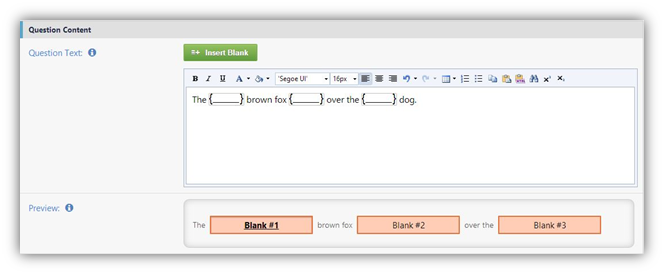The Fill in the blanks questions present examinees with a phrase or a paragraph that contains one or more empty text fields that needs to be answered. This question is in the Basic Types and is only available for Assessments. On the Add Question page, click on "Fill in the blanks". You will be redirected to the editor for the Fill in the blanks question.
Add a new Fill in the blanks Question

|
•In the Question Content section, you can enter your paragraph or text in the rich text editor. The output will be displayed in the "Preview" pane as you type. •To add a blank in the text, click the •To edit a blank, click on the blank(e.g.
•In the "Blank Settings" section, you can choose the answer mode to be "Text" based or "Numeric" based. •You can have the response evaluation to be "Equals" where the answer should be exactly the same as the one(s) provided or you can choose "Contains" where you can type in multiple answers in the "Correct Answer(s)" box and the answer(s) can be any of the ones(s) contained. •You can also choose whether the answer should be Case "Insensitive" or "Sensitive". •After you have finished saving the answer to the blank, click the
•In the Numeric Settings, you can choose the response to be of a certain tolerance or a certain range for the question. •Tolerance is the maximum allowed margin of error by the examinee (e.g. If the correct answer for the value of pi is set to be 3.14, you can set the lower bound tolerance to be .01 and the upper bound tolerance to be .01; this means that the correct answers can be as low as 3.13 and as high as 3.15). The values set for the tolerances can be whole numbers or decimals.
•For the Range, you can choose the minimum and maximum acceptable range for the answer. These values can be whole numbers or decimals.
|
|
To see what a Fill In The Blanks question will look like, see Fill In The Blanks Question Preview.
See Also
SwiftAssess © 2021
.png)
.png)
